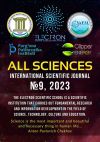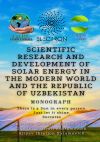Текст книги "All sciences. №7, 2023. International Scientific Journal"

Автор книги: Ibratjon Aliyev
Жанр: Математика, Наука и Образование
Возрастные ограничения: +12
сообщить о неприемлемом содержимом
Текущая страница: 2 (всего у книги 6 страниц) [доступный отрывок для чтения: 2 страниц]
USAGE PARAMETERS AND A PARTICULAR DESCRIPTION OF THE PROCESS OF CREATING PHOTOVOLTAIC DEVICES BASED ON CADMIUM TELLURIDE
UDC 621.383
Mavlonov Paxlavon IbrohimovichSenior Lecturer of the Department of «Natural Sciences» of the Faculty of Computer Engineering of the Ferghana branch of the Tashkent University of Information Technologies
Ferghana Branch of Tashkent University of Information Technologies, Ferghana, Uzbekistan
Annotation. Activity in the field of the use of semiconductor materials in the field of energy technologies today opens up a large number of opportunities, which indicates the need for further more active development and use. In addition, it is also worth paying attention to the use of a large number of different materials, among which individual representatives may stand out, dramatically increasing the overall efficiency of the entire semiconductor structure and are currently in greater priority for such a measurement in the face of binary, ternary, etc. chemical compounds.
Keywords: cadmium telluride, semiconductor elements, photovoltaic devices, efficiency, production technology, industrialization.
Аннотация. Активность в области использования полупроводниковых материалов в области энергетических технологий на сегодняшний день открывает большое количество возможностей, что говорит о необходимости дальнейшего более активного развития и использования. Кроме того, стоит также обращать внимание и на применение большого количества различных материалов среди коих могут выделяться отдельные представители, резко повышающие общую эффективность всей полупроводниковой конструкции и находящиеся на данный момент в большем приоритете по подобному измерению в лице бинарных, тернарных и т. д. химический соединений.
Ключевые слова: теллурид кадмия, полупроводниковые элементы, фотоэлектрические устройства, эффективность, технология производства, индустриализация.
Photovoltaic cells, as is known, based on the method of generating electrical energy due to the low energy that must be applied in the face of a particular radiation, operate according to the laws of photovoltaic phenomena (partial equations) (1—2).


And before giving some conclusions about this or that element, which is recognized as the main one for the semiconductor element being created, it is worth considering this chemical compound according to its various parameters. In this case, the role of such a compound is played by cadmium telluride (Fig. 1), which is a binary compound of cadmium and tellurium, and is also considered a semiconductor of the 2-a and 6-b groups with a band gap at temperatures of 300 K at 1.49 eV.

Fig. 1. Cadmium telluride crystal
The use of this element is really popular at the moment when creating solar panels, ionizing radiation detectors and photodetectors, but the mathematical basis of these phenomena still requires consideration. This material, in its normal state, is solid with a molar mass of 240.01 g / mol and a density of 5.85 g / cm3, has a melting point of 1092 degrees Celsius after its formation with a cubic structure or a sphalerite structure, also popularly popular as zinc blende.
In the formed material, the coefficient of linear thermal expansion is 5,9*10—6 1/ K when the temperature value reaches 293 K. The Young’s modulus of such a material reaches 52 Gpa with a Poisson’s ratio of 0.41. Another, for some cases, favorable moments is the circumstance of its transparency for infrared radiation from 830 nm, but negative if it is necessary to detect such classes of radiation. It should be noted that this radiation depends on an energy close to the band gap of the material of 1.5 eV at 300 K, which causes its transparency for this kind of radiation corresponding to 20 microns.

Fig. 2. Shift of fluorescence spectra in cadmium telluride
This element also has the property of fluorescence, but reaches its peak only at 790 nm. This law is effective only for massive crystals, but when their size decreases comparatively and can reach the state of reduction to quantum dots, the peak of fluorescence begins to shift by a certain value, being already in the ultraviolet range. Most of all, this dependence is personified by the fluorescence spectrum of cadmium telluride for various sizes, where the size of colloidal particles increases from about 2 to 20 nm, and some quantum well appears in the face of the reason for this peak shift (Fig. 2).
Among the chemical properties of this compound, it is not worth saying quite a lot and it is quite enough to note that it is bad it dissolves in water, has the property of interacting even with weak acids with the release of hydrogen telluride and the formation of the corresponding salt, which is quite obvious.
Based on all the presented physico-chemical descriptions of this compound, as well as finding compliance with the physico-mathematical laws of photovoltaic phenomena, it is possible in a comparative analysis to talk about the very favorable suitability of this material for the role of a semiconductor photovoltaic base for such devices with relatively high efficiency. But it is worth saying that further improvement of this technology is inevitable and requires more detailed further consideration.
Used literature1. Bovin L. A and others . Physics of compounds a-2 b-6 / edited by A. N. Georgobiani, M. K. Sheinkman. – M.: Nauka, Gl. ed. Phys.-mat. Lit., 1986. – 319 p.
2. Anselm, A. I. Introduction to the theory of semiconductors / A. I. Anselm. – L.: Nauka, 1978. – 616 p.
3. Anselm, A. I. Introduction to the theory of semiconductors / A. I. Anselm. – M.: Lan, 2008. – 624 p.
4. Anselm, A. I. Introduction to the theory of semiconductors / A. I. Anselm. – Moscow: Ogni, 1978. – 770 p.
5. Atia, M. Geometry and physics of knots / M. Atia. – Moscow: SPb. [et al.]: Peter, 1995. – 963 p.
6. Borisov, E. The key to the sun. Stories about semiconductors / E. Borisov, I. Pyatnova. – L.: Molodaya Gvardiya, 1997. – 304 p.
7. Dunlap, U. Introduction to semiconductor physics / U. Dunlap. – M.: Publishing House of Foreign Literature, 2011. – 430 p.
8. Zeldovich, Ya. B. Higher mathematics for beginners and its applications to physics / Ya. B. Zeldovich. – Moscow: RSUH, 1983. – 794 p.
9. Zeldovich, Ya. B. Higher mathematics for beginning physicists and technicians / Ya. B. Zeldovich, I. M. Yaglom. – Moscow: IL, 1982. – 108 p.
10. Ioffe, A. F. Selected works (volume 2). Radiation, electrons, semiconductors: monogr. / A. F. Ioffe. – Moscow: Nauka, 1976. – 552 p.
11. Kurchatov, I. V. I. V. Kurchatov. Collection of scientific papers in 6 volumes. Volume 1. Early works. Dielectrics. Semiconductors / I. V. Kurchatov. – L.: Nauka, 2005. – 576 p.
12. Ladyzhenskaya, O. A. Boundary value problems of mathematical physics / O. A. Ladyzhenskaya. – Moscow: Gostekhizdat, 1975. – 810 p.
13. Levinstein, M. E. Acquaintance with semiconductors / M. E. Levinstein, G. S. Simin. – M.: The main editorial office of physical and mathematical literature of the publishing house "Nauka", 1984. – 240 p.
14. Levinstein, M. E. Acquaintance with semiconductors / M. E. Levinstein, G. S. Simin. – M.: Institute of Computer Research, 2004. – 208 p.
15. Mikhlin, S. G. Course of mathematical physics / S. G. Mikhlin. – Moscow: Higher School, 2005. – 947 p.
16. New semiconductor devices: Chemistry, physics, semiconductor technology. – M.: Gostekhizdat, 1975. – 748 p.
17. Ormont, B. F. Introduction to physical chemistry and crystal chemistry of semiconductors / B. F. Ormont. – M.: Higher School, 1975. – 490 p.
18. Rectoris, K. Variational methods in mathematical physics and engineering / K. Rectoris. – Moscow: Higher School, 1985. – 363 p.
19. Slater, J. Dielectrics. Semiconductors. Metals / J. Slater. – M.: Mir, 2001. – 648 p.
20. Ugai, Ya. A. Introduction to semiconductor chemistry / Ya. A. Ugai. – M.: Higher School, 1975. – 302 p.
21. Frank, F. Differential and integral equations of mathematical physics (part 2) / F. Frank, R. Mises. – Moscow: IL, 1990. – 467 p.
THE USE OF ELECTROMAGNETIC FIELDS TO IMPROVE THE OVERALL EFFICIENCY OF PLANT GROWTH IN THE PHYSICO-BIOLOGICAL SENSE
UDC 581.132
Kadyrbergenov Fozil Kudratovich2nd year student of the Department of «Electronics and Instrumentation» of the Faculty of Computer Design Systems of the Fergana Polytechnic Institute
Ferghana Polytechnic Institute, Ferghana, Uzbekistan
Annotation. The development of various kinds of achievements in modern science leads to an acceleration of the process of determining a new kind of invention and the impact of one of the phenomena on others. The proof of this can be a technology that has never been mentioned, but is only now actively developing as a separate method, namely, the technology of accelerating plant growth through the influence of electromagnetic fields on them and on the soil occupied by them.
Keywords: electromagnetic field, physico-biological processes, photosynthesis, growth acceleration, plants.
Аннотация. Развитие самого разного рода достижений в современной науке ведёт к ускорению процесса определения нового рода изобретений и воздействия одного из явлений на другие. Доказательством тому может служить технология, никогда упоминаемая, но лишь ныне активно развивающаяся в роли отдельного способа, а именно технология ускорения роста растений посредством влияния на них и на занимаемую ими почву электромагнитных полей.
Ключевые слова: электромагнитное поле, физико-биологические процессы, фотосинтез, ускорение роста, растения.
The process of plant growth itself, as is known, is based on a whole array of various physical, chemical and biological phenomena, each of which contributes to the overall growth, however, one of the processes can affect quite quickly, the other on the contrary – makes less effort, but also remains important. Responsible for their specific area in the whole overall process. The growth itself is explained by the active cell division of the plant itself, for which it expends certain energy resources, as the same ATP molecules, as well as biological ones. For example, for the initial synthesis of proteins, after contact with deoxyribonucleic acid (DNA) with transcriptase in the nucleolus and the formation of information ribonucleic acid (i-RNA), as well as its subsequent transfer through the cytoplasm to ribosomes, where the synthesis of all necessary proteins is carried out, it is necessary to introduce «materials» there as transport RNA.
In order for each of the cells to receive the necessary material in the role of food, which the cell absorbs through its shells and directs the necessary inhibitor proteins that break it down into parts, as well as in the Golgi complex, enzymes that form from them necessary for reproduction. Moreover, when a cell receives everything necessary for the continuation of the "genus", its nucleus first begins to divide, of course, with the copying of DNA and chromosomes in the nuclei, although the loss of transcriptase at the ends. Further, the necessary vacuoles and other parts of the cell also begin to be equally distributed, eventually increasing the cell to the state until finally the outer shell forms two new cells from this mass, so one cell divides and thus the whole plant grows, if necessary, receiving additional chemical and biological "signals" for division in one or another form. For example, turning already from stem cells into cells of leaves, petals, etc.
When the process itself is more or less presented, although not in great detail, it is worth turning to ways to increase the speed of this growth. In order to obtain nutrients, a large number of familiar noble plants use their roots, most often absorbing water rich in minerals and enzymes dissolved in it. And also, it receives energy from the Sun using photosynthesis, a complex process during which a plant absorbs carbon dioxide through its leaves and releases oxygen, although in its normal state it also absorbs oxygen, like most living organisms. When all the necessary enzymes are collected, chlorophyll comes into play – perfectly accepting solar radiation and converting it into ATP molecules, and those in turn help transform the simplest and elementary compounds received into full-fledged enzymes necessary for plant growth.
An increase in sunlight would lead to the fact that the plant could get burned, as this would lead to rapid evaporation of moisture on its surface and rapid drying. So, the plant, protecting its stem, grows leaves, also providing large areas for absorbing the gases it needs, including carbonate from the air. If we resort to the method of saturating the atmosphere surrounding the plant with various gases necessary for it, then their overdose would lead to the fact that some processes could accelerate or increase their volume for a short time, but others would simply stop, again leading to the death of the plant. For example, if you enrich the surrounding space with carbonate, in order for the plant to produce photosynthesis better, this would lead to the fact that it simply could no longer be in its usual state – absorbing oxygen and releasing this very carbon dioxide, carbonate, which would slow down most processes.
The last method of influence remains – the improvement of the soil and the directed nutrients. But even in this case, it is necessary to approach as carefully as possible, because if you enrich the soil too much, the plant will either not be able to stay on the soil surface due to the fact that the soil will become too loose, or simply will not be able to absorb such a volume of compounds. For this reason, the most careful and verified method of influencing the plant and soil with an electromagnetic field was chosen.
The whole secret lies in the fact that for the most part, enriching enzymes contain metal atoms dissolved in water or residing in the soil, due to which, after exposure to an electric and magnetic field, the flow of water together with the necessary compounds begins to help the capillary effect responsible for raising the liquid to the tops of the plant and helping its growth. Due to this, the plant does not need to make too much effort, getting a larger volume of substances, but also being within the limits of what it can perceive. It is for this reason that this method is one of the most favorable and possible to implement on a large scale.
So, as an experiment, an electromagnet with a length of 100 meters was made, an electrical circuit of 10 transistors, 2 resistors, a 12—24 volt power supply was connected to it. At the same time, there was only one turn on each layer of the electromagnet, which is why the electromagnet itself was somewhat flattened and a plant could be placed on it. To detect the presence of the field, a second electromagnet was created, several times smaller and connected to light bulbs that were switched on under the influence of electromagnetic induction (Fig. 1).

Fig. 1. Photo of the experiment with a plant sprouted without sunlight and an electromagnet
The system was initially supplied with a voltage of 5 volts and 1 ampere, after which it was converted to 1 kV, and the current frequency reached 35.4991 kHz (Fig. 2—3).

Fig. 2. Diagram on the oscilloscope of the supplied alternating current

Fig. 3. Diagram of the applied electromagnet
Thus, the plant gets the opportunity to increase the growth rate of the plant, which was demonstrated by an experiment conducted in laboratory conditions. The experiment compared the growth rates of a plant that was under sunlight and a plant whose photo was given (Fig. 1) and which achieved its result of sufficient growth in 5 days, using the above parameters for the current applied with voltage, strength and frequency of the current.
As a result of the work carried out, it became possible to prove not only in a theoretical but also in a practical sense the effectiveness of this technology of using electromagnets to accelerate plant growth, which can also be represented in a larger sense (Fig. 4).

Fig. 4. Greenhouse-scale improvement model
1 – fertile soil with a depth of 200—300 mm; 2 – safety system; 3 – sand with a depth of 50 mm; 4 – induction-electromagnetic carpet; 5 – the basis for the installation of the grid; 6 – thermal insulation; 7 – soil; 8 – touch thermostat (temperature sensor).
Thus, it is noted that there is a direction for the further development and scaling of such technology, which can bring no small benefit to all mankind.
Used literature1. Apollonsky S. M., Kalyada T. V., Sindalovsky B. E. Human life safety in electromagnetic fields; Polytechnic – M., 2011. – 264 p.
2. B. Blake Levitt Protection from electromagnetic fields; SINTEG – Moscow, 2013. – 448 p.
3. Vasiliev Nikolay Microorganisms in the electromagnetic field; Lights – Moscow, 2011. – 112 p.
4. Vladimirov S. A. Symmetry groups of differential equations and relativistic fields; [not specified] – M., 2011. – 112 p.
5. Haaz A. Introduction to theoretical Physics. Mechanics. Theory of electromagnetic field and light. Thermodynamics: monogr.; Lenand – M., 2015. – 354 p.
6. Gekker I. R. Interaction of strong electromagnetic fields with plasma; Atomizdat – M., 2014. – 312 p.
7. Grigoriev V. I., Grigorieva E. V., Rostovsky V. S. Baroelectric effect and electromagnetic fields of planets and stars; Mir – Moscow, 2014. – 192 p.
8. Demirchyan, K.S.; Chechurin, V. L. Machine calculations of electromagnetic fields; Higher School – M., 2015. – 240 p.
9. Dokuchaev Denis The effect of the electromagnetic field on Tilapia; IL – Moscow, 2014. – 550 p.
10. Iwasawa K. Local theory of class fields; [not specified] – M., 2015. – 353 p.
11. Krasnoselsky M. A., Perov A. I., Povolotsky A. I. Vector fields on a plane; [not specified] – M., 2016. – 842 p.
12. Abaimov, V. F. Dendrology. Textbook for academic baccalaureate / V. F. Abaimov. – M.: Yurayt, 2016. – 444 p.
13. Antsyshkina, A.M. Botany. Guidelines for educational practice / A.M. Antsyshkina, E. I. Barabanov. – M.: Medical Information Agency, 2013. – 144 p.
14. Antsyshkina, A.M. Botany. Guide to educational practice for students / A.M. Antsyshkina, E. I. Barabanov, L. V. Mostova. – M.: Medical Information Agency, 2006. – 104 p.
15. Afanasyeva, N. B. Introduction to plant ecology / N. B. Afanasyeva, N. A. Berezina. – M.: Publishing House of Moscow State University, 2011. – 800 p.
16. Barabanov, E. I. Atlas of Botany. Anatomy, morphology and systematics of higher plants / E. I. Barabanov. – M.: Medical Information Agency (MIA), 2013. – 276 p.
17. Basov, V. M. Practicum on anatomy, morphology and systematics of plants / V. M. Basov, T. V. Efremova. – M.: Librocom, 2010. – 240 p.
TECHNICAL SCIENCES
THE GENERAL PICTURE OF THE DEVELOPMENT OF THE TECHNOLOGY OF INDUSTRIAL AUTOMATION OF THE TECHNOLOGICAL PROCESS OF INSTALLING PARTS OF THE AUTO WINDOW HEATING SYSTEM
UDC 681.5
Sayitov Shavkat SamiddinovichLecturer of the Department of «Electronics and Instrumentation» of the Faculty of Computer Design Systems of the Fergana Polytechnic Institute
Ferghana Polytechnic Institute, Ferghana, Uzbekistan
Annotation. A huge number of technologies used today have different levels of impact on modern industry, among which we can note the importance of using automated systems to increase overall efficiency on an industrial scale. Thanks to this, the work on achieving new opportunities that become useful on the way of industry development becomes relevant today.
Keywords: auto glass heating system, automotive industry, auto window installation system, automation of heating installation system, technology detailing.
Аннотация. Огромное количество технологий используемые на сегодняшний день обладают различным уровнем воздействия на современную промышленность, среди чего можно отметить важность применения автоматизированных систем для повышения общей эффективности в индустриальном масштабе. Благодаря чему актуальной на сегодняшний день становится работа по достижению новых возможностей становящиеся полезными на пути развития индустрии.
Ключевые слова: система обогрева автостёкол, автомобильная промышленность, система установки авто-окон, автоматизация системы установки обогрева, детализация технологий.
The initial stage on the way to improving this direction is its study and consideration from a variety of aspects and sides, which begins with a description of the technology for installing auto glass heating systems in the automotive industry [1-3]. In this case, it is worth paying attention to the components of the auto glass heating system, represented by describing the very initial structural diagram of the heater connection, using the electrothermal device of the car, through the use of the grid itself, the battery and some connecting elements [4-7].
The next stage is the study of the technology of installing the rear window heating grid, consisting of the stages of its study by understanding the structure of the heating conductor, along with the analysis of its manufacturing methods and the study by structural analysis of its chemical component, along with the direct determination of the installation of heating conductor systems [7-13]. But this is not the final point, since it is also worth describing along with this the algorithm for soldering the formed contact, also known and more often used under the name of the auto glass heating terminal to the heating grid, which has in its component the original design and standards of this terminal, the soldering technology of this terminal, the necessary devices and materials used in this case for the above driven soldering process, automated technological devices for soldering terminals or terminals to the driven heating system [13-17].
At this point, the initial study of the theoretical justification of the ongoing engineering research work is completed, consisting in the creation of an "Automatic Soldering Device" ("UAP"), the project of which will later be cited as the main part of the work, in which the general project of an automated device "UAP" is given. Subsequently, after the description of the project itself with the introduction of a three-dimensional model and types of its drawings, the technical parameters of the mechanical and individual parts of the automated device present in the structure of the equipment are given.
Moreover, there is also a block diagram of an automated system, which includes the designation and demonstration in various aspects of the type of device, and also takes into account the parameters of microprocessor electronic devices, among which there is also a touch panel system, to demonstrate the state of the operating device, along with the display of sensor data, electric drives and other details of the overall system. This is the reason for the description of each model of the sensor used with its description, characteristics, location of the installation and other details of the action. However, of course, descriptions of not only sensors and the mechanical system, but also other important elements, namely the mechanics of automatic transmission of terminals during soldering, which is also present, speeding up the whole process, are of great importance.
Also, among the elements, the automated system of soldering material – solder is of no small importance also during the soldering process, which once again proves the possibility of determining the device "UAP" in an automated key, as well as the fact of its semi-autonomy, together with the description and presentation of data on the software of the automated device "UAP" as a block-a scheme and a private programming language used to represent an action algorithm represented by a computer system and sensory output.
After the description of the "UAP" device itself with all its detailed components has been given, the description of the device in action or, more precisely, a full-fledged representation of the action of the entire structure presented above is of no small importance. Such a process begins with the presentation of full-fledged data on the conducted experimental tests of various parts of the automated installation "UAP" for the soldering process.
In the future, the actual physical and mathematical modeling of the moment of temperature control in the soldering process is given, taking into account the matrix-modulation mathematical apparatus aimed at division and partially indicative, in the following, similarly, by carrying out appropriate calculations, solving partial differential equations and other actions, thanks to this, a general description and a graphical physical and mathematical representation were given, taking into account all the necessary correlations of the temperature control process during the soldering process.
However, of course, this process is not an isolated one and requires analysis not only of thermal adjustment, but also of the moment of control of the pressing force, which perhaps at first glance would not be of great importance, but as the physical and mathematical modeling of this aspect has shown, it has an average correlation ability on the algorithm and the overall efficiency of the soldering process, for due to this, a mathematical model was created for controlling the force of pressing the terminal to the window in the soldering process.
After the theoretical and modulation issues have been resolved from the point of view of physical and mathematical research of a projection-constructive nature, the question of the technological application of the automated system recreated in the process described above is relevant. Along with this, such a description serves as a full-fledged instruction on the way to use the device for the listed functions.
The conclusion of such an analysis also contains descriptions of new solutions produced during the creation, testing, physical and mathematical modeling, in particular, in general terms and in individual cases-phenomena, analysis from technical, economic, physical and other points of view of efficiencies, as well as other processes described during the research work. And at the same time, special attention is given to the presentation of economic efficiency directly, with the presentation of its calculation, but at the same time, the issue of direct and immediate introduction of such a device in the industrial plan is of great importance, with the presentation of some promising and very promising results already obtained, symbolizing the importance of this kind of technology and its implementation with further possibilities for its improvement in private and general structural-scale plan.
Внимание! Это не конец книги.
Если начало книги вам понравилось, то полную версию можно приобрести у нашего партнёра - распространителя легального контента. Поддержите автора!Правообладателям!
Данное произведение размещено по согласованию с ООО "ЛитРес" (20% исходного текста). Если размещение книги нарушает чьи-либо права, то сообщите об этом.Читателям!
Оплатили, но не знаете что делать дальше?








































